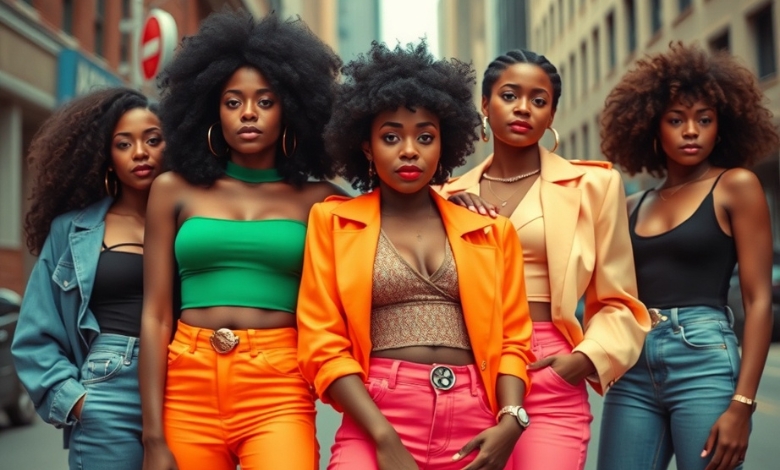Explore iconic 80s fashion Black women rocked, bold styles, cultural pride, and timeless influence that redefined beauty and power.
Let’s get this straight, 80s fashion wasn’t just neon leggings and oversized blazers. For Black women, it was a revolution stitched into fabric, a loud-and-proud declaration of identity, resilience, and power. It wasn’t just about what they wore, but how they wore it, and why.
ip
Walk down memory lane, and you’ll find more than shoulder pads and bold prints. You’ll find cultural resistance. You’ll find innovation in hairstyles, in accessories, in silhouettes that broke every rule the mainstream ever set. This is a deep dive into the world Black women shaped with their 80s fashion, fearless, flamboyant, and unapologetically theirs.
What You'll Discover:
Why 80s Fashion for Black Women Was So Unique
Rebellion in Fabric
In a world that tried to box them in, Black women in the 80s used fashion to break out. They fused streetwear with elegance, Afrocentric influences with urban grit. They weren’t trying to blend in, they were making statements.
Leather jackets over Ankara skirts. Gold rope chains with kente headwraps. It wasn’t a contradiction, it was a layered identity screaming to be seen.
More Than a Trend, It Was Cultural Expression
Fashion in the Black community during the 80s wasn’t about catching up to trends. It was about creating them. From the club scenes of New York to the church pews in Alabama, style was political. It wasn’t about subtle cues, it was a billboard of pride.
Iconic Style Elements That Defined 80s Fashion for Black Women
Power Shoulders and Power Stances
Padded shoulders were everywhere in the 80s, but Black women turned them into armor. Picture women like Grace Jones, walking into rooms like thunder in human form. Those shoulders weren’t just fashionable, they were defiant. They symbolized strength in spaces that often overlooked them.
The broader the shoulders, the bolder the presence.
Acid Wash and Denim Rebellion
Denim ruled the streets. From high-waisted acid-wash jeans to cropped jackets with rhinestone flare, Black women made denim a canvas. They weren’t just wearing jeans, they were remixing them. Pins, patches, and hand-painted slogans made each pair unique. It was wearable graffiti.
Denim became a kind of street poetry, raw, loud, and impossible to ignore.
Afrocentric Prints and African Royalty Energy
The late 70s had planted the seeds of Afrocentrism, but in the 80s, Black women wore it like a crown. Dashikis, wax prints, headwraps, all worn with a modern twist. The fabrics weren’t just beautiful. They were resistance wrapped in cotton. They said: “We know where we come from.”
Pair that with futuristic shades and bamboo earrings, and you had a look that could stop traffic and start conversations.
Hair as High Fashion: The Crown Wasn’t Optional
Jheri Curls, Afros, and Braids With a Twist
Hair in the 80s wasn’t just an accessory, it was center stage. The Jheri curl wasn’t just a hairstyle; it was a full-blown era. Slick, juicy curls bounced in music videos and street corners alike. Meanwhile, afros stayed strong, symbolizing rootedness and rebellion.
Then came braids. Not the neat, schoolgirl type. Think big, bold, and beaded. Every braid was a flex, every cornrow a piece of art. And let’s not forget the influence of hip-hop, box braids with gold cuffs, side-swept bangs, and shaved designs were born in that fire.
Hair as Identity and Protest
The hair game was more than beauty, it was resistance. In a time when Eurocentric beauty ideals still ruled, Black women said “Nah” with every twist, curl, and puff. They reclaimed their strands. They created spaces where natural hair wasn’t just accepted, but celebrated.
Accessories That Spoke Louder Than Words
Gold Chains, Bamboo Earrings, and Door-Knockers
The accessories of the 80s were loud, chunky, and proud. Gold chains weren’t just a hip-hop staple, they were a declaration of status. Bamboo earrings (yes, the ones “at least two pair”) framed faces with attitude. Door-knocker earrings almost touched shoulders, adding rhythm to every head nod.
It wasn’t over-accessorizing. It was over-emphasizing a point: Black women don’t do subtle.
Statement Belts, Sunglasses, and Gloves
Belts cinched waists in oversized blazers, not just to show shape but to draw eyes. Sunglasses? The bigger, the better. They shielded from the sun and the judgment. Gloves? Think lace, leather, or fingerless, channeling both Madonna and a Brooklyn block party.
Media Influence: Icons Who Shaped 80s Fashion for Black Women
Grace Jones – The Androgynous Architect of Fearless Fashion
She didn’t just push boundaries, she bulldozed them. Grace Jones owned androgyny, turned masculinity into a form of feminine power, and never apologized for her sharp lines or sharper presence. Her outfits were architectural, her style a walking art exhibit.
If the 80s needed a face for avant-garde Black fashion, Grace was it.
Janet Jackson – Control and Coordination
With her military-inspired outfits, matching sets, and slick ponytails, Janet Jackson defined another lane. She gave choreography and costume equal weight. Velvet crop tops, cinched jackets, black boots, her look was rebellious but refined.
She was softness wrapped in structure, a perfect contradiction.
Salt-N-Pepa – Street Chic Redefined
Salt-N-Pepa didn’t just rap, they dressed like every lyric was stitched into their jackets. Their outfits, bright leathers, color-blocked jackets, asymmetrical cuts, defined hip-hop chic. Black women saw themselves reflected in their flyness. They were bold and streetwise with a sense of fun and fearlessness.
The Role of Hip-Hop in Shaping the Look
Street Style Becomes High Fashion
By the mid-80s, hip-hop was bleeding into mainstream consciousness, and with it came a tidal wave of style. Kangol hats, Adidas tracksuits, and Dookie chains weren’t just for the boys. Black women grabbed those looks and made them feminine, fierce, and forward-thinking.
You’d see women in cropped leather jackets, Reebok Freestyles, and asymmetrical cuts that played with proportions. Hip-hop didn’t just influence Black women’s fashion, it exploded into a full-on aesthetic that still echoes today.
Fashion in the Church, at the Club, and on the Block
Sunday’s Best Wasn’t Just for Sunday
In Black churches during the 80s, the fashion was regal. Big hats, brooches, matching suits with shoulder pads that could knock someone into next week. It wasn’t over the top, it was tradition. It was dressing up to honor community, faith, and ancestors.
Church fashion was a style sermon.
The Club Was a Fashion Battlefield
In the clubs, fashion turned competitive. Sequins, metallics, bodycon dresses, and slouch boots ruled the dance floor. It wasn’t about minimalism, it was about visibility. The louder the look, the better the night. Women didn’t just enter rooms, they entered scenes, like opening acts for their own lives.
Everyday Fashion: The Art of Casual Cool
From high schools to stoops, casual wear had its own flavor. Oversized tops with leggings, denim skirts with slouch socks, varsity jackets with hoop earrings, everyday style had layers of personality.
Even if it looked effortless, you better believe thought went into every combo.
Legacy and Revival: Why It Still Matters Today
80s Fashion Is Still Everywhere
Ever seen a teen on TikTok rocking a windbreaker, chunky sneakers, and gold hoops? That’s 80s Black fashion, recycled with Gen Z flair. The revival isn’t accidental. It’s a nod to a time when fashion had stakes. When getting dressed was an act of visibility.
Today’s Black influencers and artists are still channeling that spirit, whether it’s Solange in sculptural silhouettes or Cardi B in wild prints. The DNA is 80s, with modern mutations.
Fashion Was and Still Is a Language
The 80s gave Black women a new visual language. One that spoke of survival, creativity, joy, and refusal. It’s a language still spoken on runways, red carpets, and sidewalks across the globe.
Understanding 80s fashion for Black women is like unlocking a cultural time capsule. You can’t just skim the surface. You’ve got to feel the texture, hear the soundtrack, and smell the hair grease. It’s alive.
Key Takings
- 80s fashion for Black women was not just style, it was a cultural statement of identity, power, and protest.
- Iconic elements like power shoulders, bold prints, acid-wash denim, and Afrocentric fabrics defined the era.
- Hair played a central role in expression, from Jheri curls and afros to braided styles that were both beautiful and bold.
- Accessories, like bamboo earrings, gold chains, and oversized sunglasses, were loud and proud, amplifying the wearer’s personality.
- Media icons like Grace Jones, Janet Jackson, and Salt-N-Pepa heavily influenced mainstream acceptance of Black women’s 80s style.
- Hip-hop’s rise gave Black women new spaces to define their style, blending streetwear with high fashion aesthetics.
- Today’s fashion revival is no coincidence, it’s a continuation of the radical, creative energy born in the 80s.





